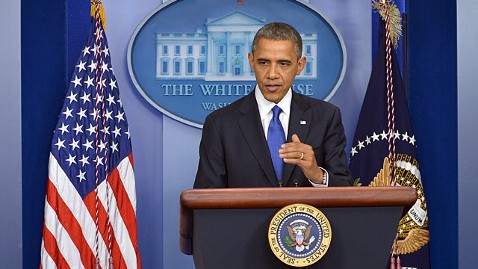
Mandel Ngan/AFP/Getty Images
WASHINGTON D.C. – Ten days remain before the mandatory spending cuts and tax increases known as the “fiscal cliff” take effect, but President Obama said he is still a “hopeless optimist” that a federal budget deal can be reached before the year-end deadline that economists agree might plunge the country back into recession.
“Even though Democrats and Republicans are arguing about whether those rates should go up for the wealthiest individuals, all of us – every single one of us -agrees that tax rates shouldn’t go up for the other 98 percent of Americans, which includes 97 percent of small businesses,” he said.
He added that there was “no reason” not to move forward on that aspect, and that it was “within our capacity” to resolve.
The question of whether to raise taxes on incomes over $250,000 remains at an impasse, but is only one element of nuanced legislative wrangling that has left the parties at odds.
For ABC News’ breakdown of the rhetoric versus the reality, click here.
At the White House news conference this evening, the president confirmed he had spoken today to Senate Majority Leader Harry Reid, D-Nev., and House Speaker John Boehner, R-Ohio, although no details of the conversations were disclosed.
The talks came the same day Speaker Boehner admitted “God only knows” the solution to the gridlock, and a day after mounting pressure from within his own Republican Party forced him to pull his alternative proposal from a prospective House vote. That proposal, ”Plan B,” called for extending current tax rates for Americans making up to $1 million a year, a far wealthier threshold than Democrats have advocated.
Boehner acknowledged that even the conservative-leaning “Plan B” did not have the support necessary to pass in the Republican-dominated House, leaving a resolution to the fiscal cliff in doubt.
“In the next few days, I’ve asked leaders of Congress to work towards a package that prevents a tax hike on middle-class Americans, protects unemployment insurance for 2 million Americans, and lays the groundwork for further work on both growth and deficit reduction,” Obama said. ”That’s an achievable goal. That can get done in 10 days.”
Complicating matters: The halls of Congress are silent tonight. The House of Representatives began its holiday recess Thursday and Senate followed this evening.
Meanwhile, the president has his own vacation to contend with. Tonight, he was embarking for Hawaii and what is typically several weeks of Christmas vacation.
However, during the press conference the president said he would see his congressional colleagues “next week” to continue negotiations, leaving uncertain how long Obama plans to remain in the Aloha State.
The president said he hoped the time off would give leaders “some perspective.”
“Everybody can cool off; everybody can drink some eggnog, have some Christmas cookies, sing some Christmas carols, enjoy the company of loved ones,” he said. “And then I’d ask every member of Congress, while they’re back home, to think about that. Think about the obligations we have to the people who sent us here.
“This is not simply a contest between parties in terms of who looks good and who doesn’t,” he added later. “There are real-world consequences to what we do here.”
Obama concluded by reiterating that neither side could walk away with “100 percent” of its demands, and that it negotiations couldn’t remain “a contest between parties in terms of who looks good and who doesn’t.”
Boehner’s office reacted quickly to the remarks, continuing recent Republican statements that presidential leadership was at fault for the ongoing gridlock.
“Though the president has failed to offer any solution that passes the test of balance, we remain hopeful he is finally ready to get serious about averting the fiscal cliff,” Boehner said. “The House has already acted to stop all of the looming tax hikes and replace the automatic defense cuts. It is time for the Democratic-run Senate to act, and that is what the speaker told the president tonight.”
The speaker’s office said Boehner “will return to Washington following the holiday, ready to find a solution that can pass both houses of Congress.”













